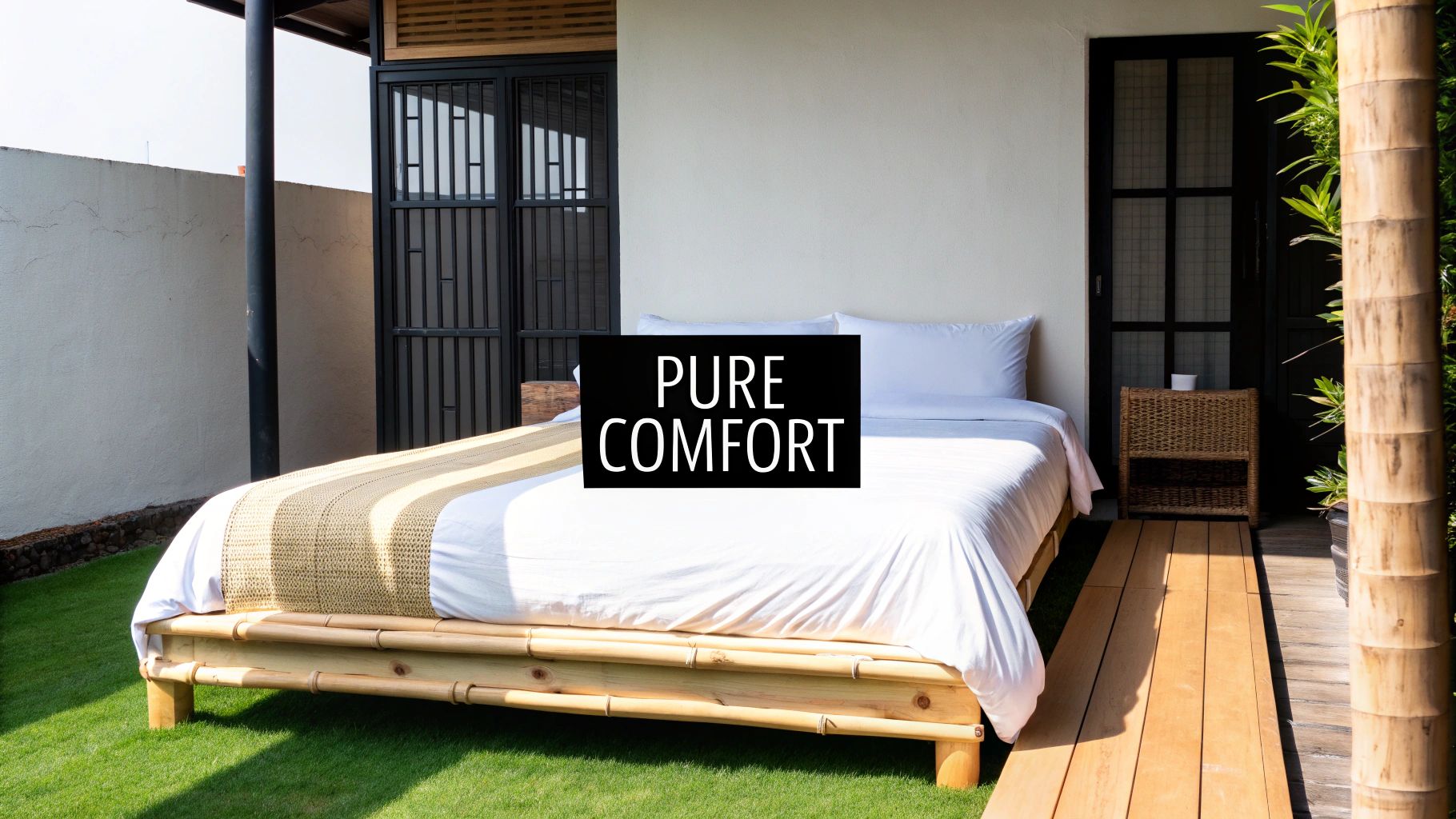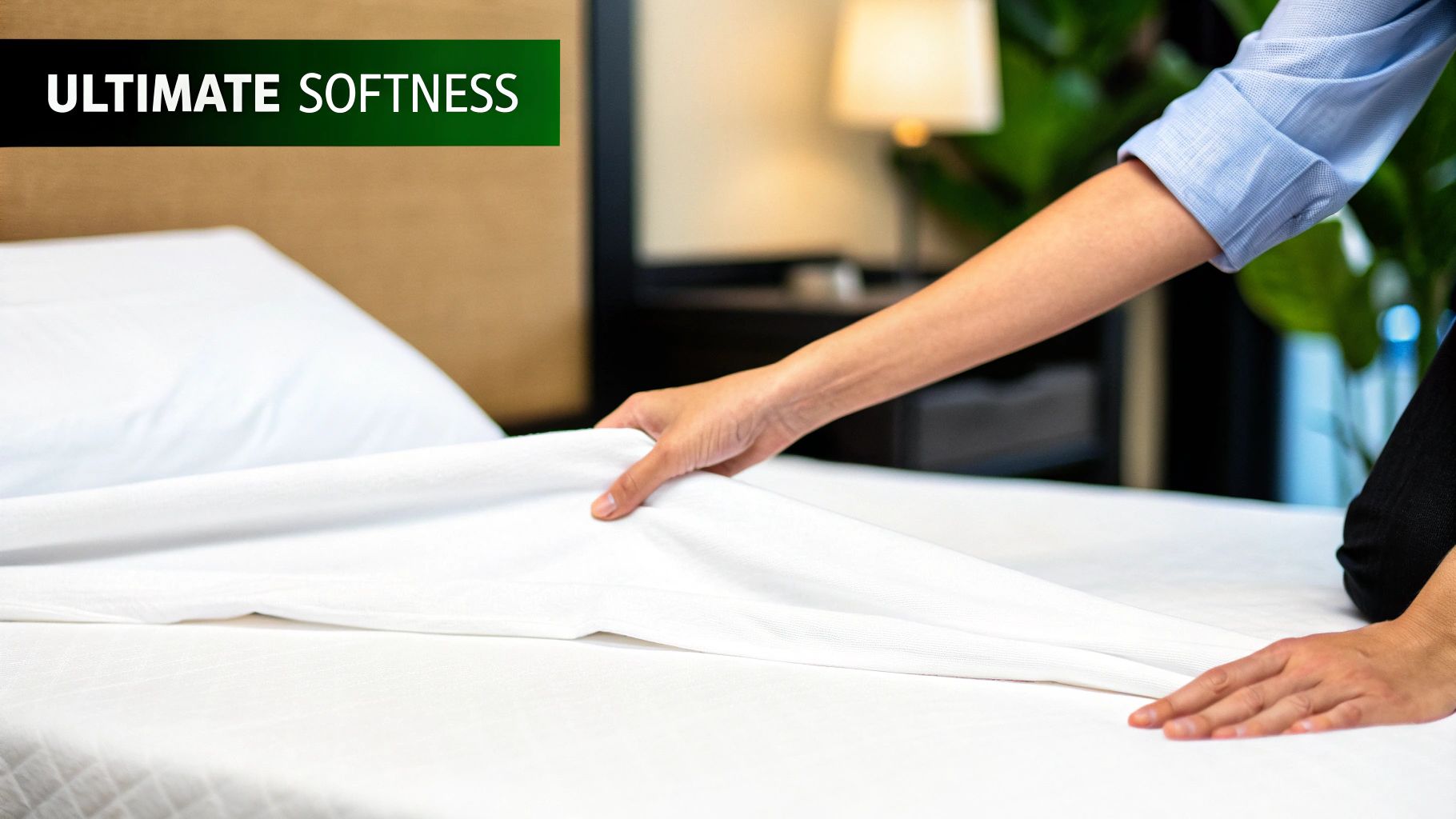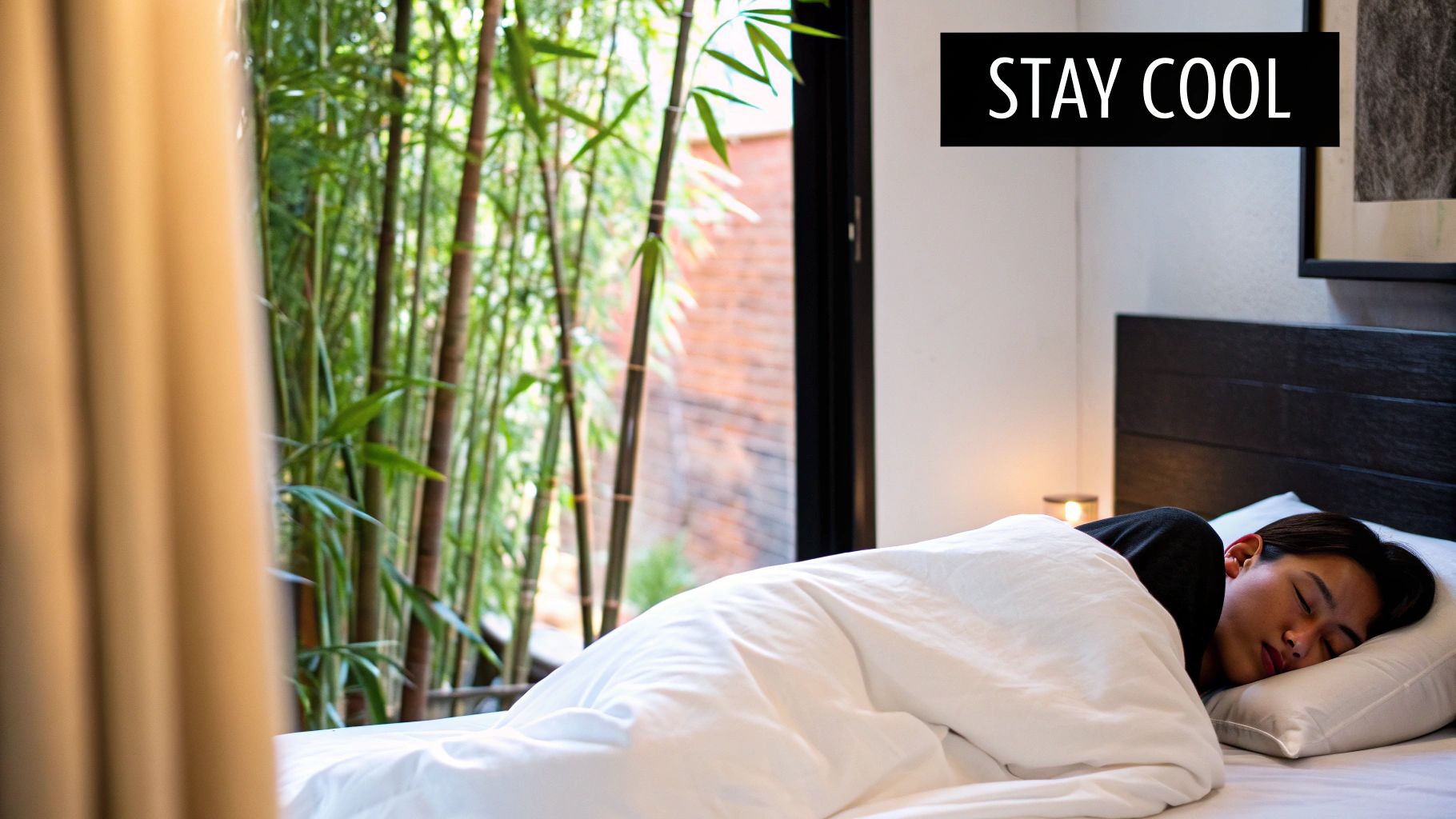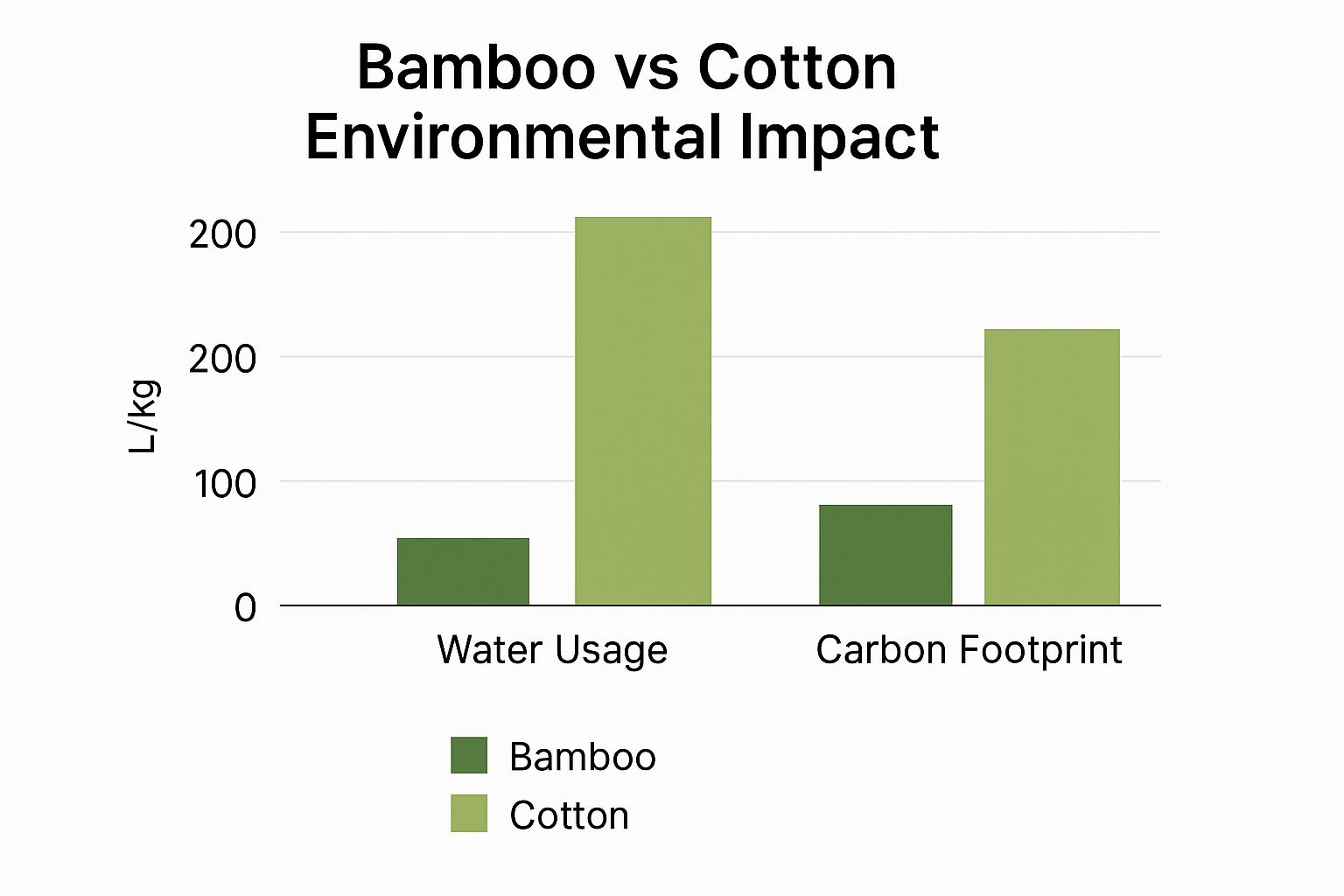Ever dreamed of sleeping on a cloud? Then it’s time to discover 100 bamboo bedding. Forget the hard bamboo stalks you see in nature; this is a silky, durable fabric made from bamboo pulp, celebrated for its incredible softness and eco-friendly reputation. If you're looking for an immediate upgrade to your sleep quality, you've found it.
The Journey from Plant to Pillowcase

It’s hard to imagine that tough bamboo grass can become something so soft you want to sleep in it. The secret lies in a fascinating process that turns a hardy plant into a textile that rivals high-end silk.
Think of it less like carving wood and more like making fine wine. The raw material undergoes a total transformation to create something truly refined and luxurious.
From Harvest to Pulp
It all starts with harvesting mature bamboo. Unlike trees, bamboo is a grass that regrows from its own roots, making it a highly renewable resource. After harvesting, the woody parts are crushed to extract the natural cellulose inside.
This cellulose is then dissolved into a thick, honey-like pulp. This is a crucial step, transforming the raw plant matter and preparing it for its complete makeover into fabric.
The result is a pure, raw material ready to be spun. This pulp is the foundation for creating the long, smooth fibres that give 100% bamboo bedding its signature silky feel and strength.
Spinning the Silky Fibres
Next, the pulp is pushed through tiny spinnerets—think of them like microscopic showerheads. As the pulp streams out, it solidifies into fine, long filaments. These are then spun into threads, which are woven to create the final fabric.
This process is what makes the fibres so smooth and round, unlike the shorter, rougher fibres in traditional cotton. It’s this structural difference that makes bamboo fabric feel so gentle on your skin. To learn more, explore everything you need to know about bamboo sheets in our detailed guide.
Why Is It Called Bamboo Viscose or Lyocell?
You'll often see bamboo fabric labelled "bamboo viscose" or "bamboo lyocell." These names simply refer to the specific manufacturing process used.
- Viscose Process: This is the most common method. It's very effective at turning wood pulp into fabric, but traditionally uses chemicals that require careful management to minimise environmental impact.
- Lyocell Process: This is a more modern, eco-friendly approach. It uses a non-toxic solvent in a "closed-loop" system where over 99% of the water and solvent are captured and reused. This makes lyocell a brilliant choice for anyone prioritising sustainability.
Both methods result in the wonderfully soft fabric we know as 100% bamboo bedding. Understanding how it’s made helps you appreciate the quality woven into every set.
The Unforgettable Feel of 100% Bamboo Bedding

The first time you slip into a bed made with 100% bamboo bedding, you get it. It's an instant upgrade that turns your bed into a true sanctuary. People often compare it to high-end silk, but with a more comforting weight. The magic lies in the long, smooth bamboo fibres that glide over your skin without snagging, creating a soothing sensation that helps you unwind.
Say Goodbye to Night Sweats
If you constantly kick off the covers only to wake up cold an hour later, bamboo bedding is your solution. The fabric is filled with microscopic gaps, making it incredibly breathable and allowing air to move freely.
Think of it as a smart thermostat for your bed. On warm nights, it lets excess body heat escape. When it’s cooler, the fibres provide a layer of insulation, keeping you cosy without overheating.
One of bamboo's biggest draws is its thermo-regulating power. It naturally adapts to your body temperature, keeping you cool in summer and warm in winter, ending the nightly battle over the doona.
This natural ability to adapt means you get more stable, uninterrupted sleep, which is fundamental to your overall health.
Wake Up Dry and Refreshed
Beyond keeping you cool, bamboo fabric is also fantastic at managing moisture. Its fibres actively pull sweat away from your skin—a process known as moisture-wicking. That moisture is then spread across the fabric's surface, where it can evaporate quickly.
This has two huge benefits:
- You stay comfortable: No more waking up feeling clammy and sticky.
- It’s more hygienic: A dry environment is much less inviting for the bacteria and allergens that love damp conditions.
This powerful moisture control is a game-changer, especially for hot sleepers or those in humid climates. It’s no wonder this is catching on; the Australian home textiles market, which includes materials like bamboo, is expected to hit USD 7.57 billion by 2034, driven by demand for high-performance, natural fabrics. You can check out the full report on Australia's home textiles market growth.
When you choose bamboo, you’re not just buying new sheets—you're investing in a better sleep experience. For more tips on creating a restful space, take a look at our ideas for building a healthier sleep sanctuary.
Create a Healthier Sleep Sanctuary with 100% Bamboo Bedding
Your bed should be a clean, safe haven. But for many, bedding can be a source of sniffles, sneezes, or skin irritation. Swapping to 100% bamboo bedding can turn your bed into an environment that genuinely supports your well-being.

It all comes down to bamboo's naturally hypoallergenic qualities. Unlike many other fabrics, bamboo creates an environment where common household allergens just can't get comfortable.
Your Defence Against Allergens
Hypoallergenic means your bedding actively fights off the tiny intruders that trigger allergies and asthma. The unique structure of bamboo fibres makes it a terrible place for these common culprits to live:
- Dust Mites: These microscopic pests, a top cause of indoor allergies, find it incredibly difficult to thrive in the tightly woven, smooth fibres of bamboo fabric.
- Mould and Mildew: Because bamboo wicks away moisture so well, your sheets stay drier, robbing mould and mildew of the damp conditions they need to grow.
This natural resistance means you breathe cleaner air all night long, leading to fewer interruptions from coughing, sneezing, and stuffiness.
A study on respiratory allergies highlighted that allergen avoidance—like using hypoallergenic bedding—is a crucial first step in managing symptoms. For anyone who suffers from allergies, switching to bamboo can be a simple change that brings powerful relief.
Gentle on Sensitive Skin
If you have sensitive skin or conditions like eczema, you know how the wrong fabric can ruin your night. The friction from rougher materials can easily cause redness, itching, and flare-ups.
This is where bamboo truly shines. Its fibres are naturally smooth and round, without the sharp bits found in other threads that can irritate the skin. As a result, 100% bamboo bedding glides smoothly over your body instead of rubbing against it. This reduction in friction helps soothe sensitive skin and lets you sleep soundly.
Consider this real-world example: A family with children prone to nightly congestion and skin rashes switched to a full hypoallergenic bamboo bedding collection. The parents noticed a dramatic drop in their kids’ symptoms. The children started waking with clearer sinuses and calmer skin, proving how a small change can make a massive difference.
How Sustainable Is Bamboo Bedding, Really?
When you’re considering 100% bamboo bedding, you're likely drawn by more than just silky-smooth sleep. But with so much "greenwashing" out there, it’s smart to ask: just how sustainable is it? Once you understand the full picture, you can feel confident in your choice.
At its roots, the bamboo plant is a sustainability superstar. It's one of the fastest-growing plants on earth and shoots up without needing pesticides or fertilisers. This puts it in a different league from conventional cotton, which is notorious for its heavy reliance on chemicals.
The Good: The Plant Itself
The environmental upsides of growing bamboo are clear, especially compared to crops like cotton.
- Remarkable Growth: Bamboo is a grass, not a tree. After harvesting, it regenerates from its own roots, so there's no need for replanting, which helps prevent soil erosion.
- Water Wise: It’s incredibly water-efficient, often thriving on natural rainfall alone. This is a massive advantage in a world where fresh water is a precious resource.
- A Breath of Fresh Air: Bamboo forests are brilliant at absorbing carbon dioxide, producing about 35% more oxygen than an equivalent stand of trees.
The image below brings home the environmental edge bamboo has over cotton, particularly on water use and carbon output.

As you can see, during its growth phase, bamboo has a significantly lighter footprint, using just a fraction of the water and generating far less carbon.
A Transparent Look at Manufacturing
The journey from a woody plant to a soft fabric is where the sustainability story gets more complex. The most common method is the viscose process, which uses chemicals to dissolve the bamboo pulp. While effective, this process needs responsible management to ensure those chemicals don't harm the environment.
A more eco-friendly alternative is the lyocell process. This method uses a non-toxic solvent in a "closed-loop" system.
In a closed-loop system, over 99% of the solvent and water are captured and reused. This drastically reduces waste and minimises the environmental footprint, making lyocell-based bamboo fabric a top choice for sustainability.
Responsible manufacturing is gaining traction as more of us demand transparency. It's no surprise that the Australian bedsheet market is projected to hit USD 3,069.20 million by 2033, a growth fuelled by this rising awareness. You can get the full picture by reading the complete bedsheet market analysis.
Actionable Tip: How to Choose a Genuinely Sustainable Option
As a consumer, you have the power to support brands that do things right. The easiest way to do this is to look for certifications that guarantee the final product is safe for you and the planet.
The gold standard is the OEKO-TEX STANDARD 100 certification. This global system tests for harmful substances at every production stage. If a set of 100% bamboo bedding carries this label, it means every thread, button, and dye has been tested and confirmed to be free from harmful chemicals.
Choosing certified products is your best bet for peace of mind. It’s a straightforward way to cut through marketing noise and make a choice that aligns with your values. For more ideas on making eco-friendly choices, have a look at our guide to sustainable living materials.
A Practical Guide to Buying 100% Bamboo Bedding
Ready to find the perfect set of bamboo sheets? Choosing your ideal bedding shouldn't be complicated. Once you know what to look for, you can confidently pick a set that promises years of blissful sleep.
Bedding labels can feel like they're in another language. To cut through the noise, focus on two key things: the fabric's weave and its thread count.
Understanding Weave: Sateen vs. Twill
The way a fabric is woven dictates how it feels, looks, and performs. For bamboo, you'll generally find two main styles: sateen and twill.
-
Sateen Weave: If you love that buttery-soft, silky feel with a gorgeous, subtle sheen, sateen is for you. Its "one yarn under, three or four yarns over" pattern pushes more threads to the surface, creating that signature lustre. It's the go-to for five-star hotel luxury at home.
-
Twill Weave: You’ll recognise a twill weave by its faint diagonal lines, like the pattern on your favourite jeans. This structure makes the fabric incredibly durable and less likely to wrinkle. While more matte than sateen, it’s still wonderfully soft and a fantastic, hard-wearing choice for everyday life.
Why Bamboo Thread Count Is Different
We’ve been taught that higher thread count means better sheets. That’s true for cotton, but it's a different story with bamboo. Bamboo fibres are so naturally long and soft that you don’t need a massive thread count to get a premium feel.
In the world of bamboo bedding, the sweet spot for a perfect balance of softness, breathability, and durability is between a 300 and 400 thread count. A set in this range will often feel far more luxurious than a 1000-thread-count cotton set.
Cramming too many bamboo threads into a square inch can backfire, making the fabric heavy and less breathable. When shopping for bamboo, forget chasing huge numbers—the quality of the fibre itself is what truly matters. To see what we mean, you can shop all bedding and explore our curated collection.
Spotting Genuine Quality
How can you be sure you're getting the good stuff? Here are two simple checks to make before you buy.
First, look for "100% Bamboo" on the label (often listed as viscose or lyocell from bamboo). Some brands blend bamboo with cheaper fillers like microfibre, which undermines the natural benefits that make bamboo special.
Second, always look for an OEKO-TEX STANDARD 100 certification. This is your guarantee that every part of the product has been tested and found to be free of harmful substances. It’s a sign that the bedding is safe for you and your family.
Thanks to the convenience of online shopping, finding quality bedding has never been easier. With Australia's internet usage at 97.1%, e-commerce puts a world of choice at our fingertips. You can read more about how e-commerce is shaping the Australian bed linen market to see the bigger picture. By keeping an eye on the weave, thread count, and certifications, you’ll have everything you need to choose the perfect set of 100% bamboo bedding.
Care Tips to Make Your Bamboo Bedding Last
https://www.youtube.com/embed/c9hoxqOwVVI
You’ve brought home that silky-soft feeling of 100 bamboo bedding, and keeping it that way is surprisingly simple. With a little care, you can protect your investment and enjoy that luxurious feel for years.
The secret is to be gentle. The delicate fibres thrive with cool temperatures and mild products but don't do well with harsh chemicals or high heat, which can cause pilling or a loss of softness.
The Best Way to Wash Your Bamboo Bedding
For pristine sheets, a cold water wash (no warmer than 30°C) on a gentle cycle is best. Wash them separately from other laundry to avoid snagging from zippers and prevent lint from rougher fabrics like towels sticking to the smooth surface.
Opt for a mild, liquid detergent. It's best to avoid powdered detergents, which can leave a gritty residue. Definitely avoid bleach and fabric softeners. Bleach weakens the fibres, while fabric softeners coat the material, reducing its breathability and moisture-wicking abilities.
Pro Tip: For a natural softness boost, add half a cup of baking soda to the wash cycle. It's a fantastic, gentle alternative to chemical softeners that helps keep your sheets bright without causing damage.
Drying for Maximum Softness and Longevity
When it’s time to dry, the best method is to line dry your sheets outside. The fresh air is the gentlest approach, and a good shake before hanging helps minimise wrinkles.
If using a dryer, select the lowest heat setting or an air-dry cycle. High heat is the number one cause of shrinking and damage. For an even better result, toss in a few wool dryer balls—they'll speed up drying time, cut down on static, and prevent tangling.
Following these simple tips will ensure your 100 bamboo bedding stays as soft and inviting as the day you bought it. For a more detailed walkthrough, check out our guide on how to care for your bamboo sheets so they last for years.
Your Bamboo Bedding Questions Answered
It’s natural to have questions when trying something new. Let’s walk through some common queries about 100% bamboo bedding to help you see it as an investment in your rest and wellbeing.
Do Bamboo Sheets Wrinkle Easily?
Yes, they can, especially after the first few washes. This isn't a flaw; it's a sign of quality. It means the fabric hasn't been treated with the harsh anti-wrinkle chemicals found in other textiles.
Managing creases is simple. The best trick is to pull your sheets from the dryer while they’re still slightly warm and put them directly on your bed. The fabric's natural weight will smooth out most wrinkles on its own.
How Long Will My Bamboo Bedding Last?
With the right care, a quality set of 100% bamboo bedding will last for years, often outlasting traditional cotton. The long, strong bamboo fibres are naturally durable and less prone to pilling when handled correctly.
The secret is a gentle laundry routine. Stick to a cold wash, use a mild detergent, and skip the high heat. This protects the delicate fibres, keeping them silky-soft and strong.
A study on textile durability found that harsh washing cycles and high heat are the primary causes of premature wear in natural fabrics. Gentle care is not just a suggestion; it's the secret to getting the most out of your investment.
Is 100% Bamboo Bedding Worth the Price?
It’s a fair question. When you break it down, you're not just buying sheets; you're investing in your quality of life. For starters, you're paying for superior durability, meaning you won't be replacing them as often as cheaper alternatives.
The real value is in the sleep itself. The breathability, moisture-wicking power, and hypoallergenic qualities create a healthier, more comfortable sleep environment. For anyone who battles night sweats, allergies, or sensitive skin, the difference can be priceless. If you want to dive deeper, explore our frequently asked questions about bamboo bedding.
Think of it like buying a great mattress. The initial cost is higher, but it pays you back night after night with better rest and wellbeing.
Ready to Upgrade Your Sleep?
At Sienna Living, we believe everyone deserves a restorative night's sleep. Our 100% bamboo bedding is OEKO-TEX certified, ensuring it's free from harmful chemicals and safe for the whole family. It’s time to invest in your comfort and transform your sleep.
Discover the Sienna Living Bamboo Collection
Article created using Outrank

